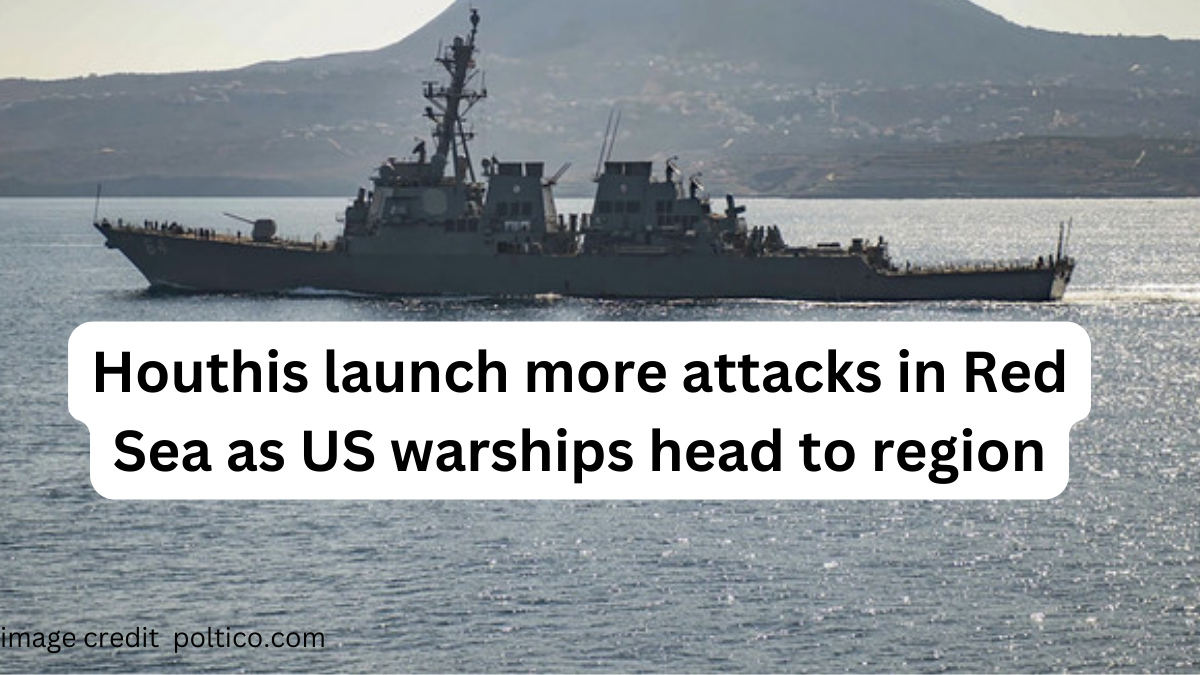The once tranquil waters of the Red Sea have transformed into a churning cauldron of tension, with Houthi rebels in Yemen Houthis attacks launching audacious drones and missiles on commercial and military vessels traversing the crucial Bab el-Mandeb Strait. These brazen assaults have not only imperiled vital shipping lanes but also sparked a wider international crisis, drawing in major global players and threatening to destabilize an already volatile region.
Table of Contents
Houthis Attacks Onslaught: Crippling Trade and Endangering Lives
Houthi rebels, locked in a bitter conflict with the Saudi-led coalition backing Yemen’s internationally recognized government, have increasingly turned to targeting maritime traffic in the Red Sea. These attacks, employing explosive-laden drones and long-range ballistic missiles, have targeted both military vessels like the US destroyers Mason and Carney and commercial ships like the Norwegian tanker MT Strinda.
The consequences of these attacks are far-reaching. Maersk, the world’s largest shipping company, has been forced to halt its operations through the Bab el-Mandeb Strait, a vital chokepoint for global trade. This disruption has sent shockwaves through the international shipping industry, threatening supply chains and potentially leading to higher costs for consumers worldwide.
Beyond the economic ramifications, the Houthis attacks also pose a direct threat to human life. The downing of a drone targeting a merchant ship on Saturday serves as a stark reminder of the potential for civilian casualties in this increasingly militarized zone.
US Steps Up Presence: Show of Force or Prelude to Wider Conflict?
In response to the escalating Houthis Attacks threat, the United States has significantly bolstered its naval presence in the region. Three additional destroyers have joined the Gerald R. Ford Carrier Strike Group already stationed in the Mediterranean, showcasing American resolve to protect freedom of navigation and deter further attacks.
However, the US involvement raises concerns about the potential for wider military escalation. The Biden administration has so far refrained from direct military action against the Houthis Attacks, opting instead for diplomatic efforts and support for the Saudi-led coalition. Yet, with American lives and interests increasingly at stake, the pressure for a more forceful response is mounting.
International Coalition in the Making: Can Cooperation Quell the Crisis?
Recognizing the gravity of the situation, the Biden administration is actively pursuing the formation of an international maritime task force to combat the Houthis Attacks threat in the Red Sea. This initiative aims to build upon the existing Combined Task Force 153, currently focused on anti-piracy and counter-terrorism operations in the region.
Expanding this coalition would represent a significant step towards de-escalating the crisis and safeguarding vital shipping lanes. However, its success hinges on securing the cooperation of key regional and international players, including Saudi Arabia, the United Arab Emirates, and European nations with vested interests in Red Sea security.
Beyond the Red Sea: Untangling the Web of Regional Tensions
The Houthis attacks on Red Sea shipping cannot be divorced from the broader context of the ongoing Yemeni civil war. This complex conflict, fueled by regional rivalries, proxy wars, and a dire humanitarian crisis, has created a breeding ground for instability and violence.
Addressing the root causes of the Yemeni conflict is crucial to achieving lasting peace and security in the Red Sea. This necessitates sustained diplomatic efforts towards a negotiated settlement, alongside measures to alleviate the humanitarian suffering of the Yemeni people.
Conclusion: A Sea of Uncertainty
The Red Sea saga stands as a stark reminder of the interconnectedness of our world and the fragility of global trade and security. The Houthi attacks serve as a potent symbol of the challenges posed by non-state actors and the ripple effects of regional conflicts.
While the immediate focus lies on mitigating the Houthi threat and protecting maritime traffic, the long-term solution lies in addressing the underlying issues fueling the Yemeni conflict and fostering regional cooperation. Only through concerted efforts on multiple fronts can the Red Sea be transformed from a volatile battleground back to a vital artery of global commerce and a symbol of regional stability.






















+ There are no comments
Add yours